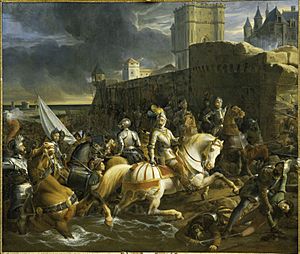Siege of Calais (1558) facts for kids
Quick facts for kids Siege of Calais |
|||||||
|---|---|---|---|---|---|---|---|
| Part of the Italian War of 1551–1559, Anglo-French War (1557–1559) | |||||||
 The Siege of Calais by François-Édouard Picot, 1838 |
|||||||
|
|||||||
| Belligerents | |||||||
| Commanders and leaders | |||||||
| Strength | |||||||
| 27,000 | 2,500 | ||||||
The French siege of Calais in early 1558 was a major event during the Italian War of 1551–1559. This war was fought between France and England, along with their allies. The siege ended with France taking control of the town of Calais.
Calais had been ruled by England for over 200 years, ever since 1347 during the Hundred Years' War. By the 1550s, Mary I of England was Queen of England, and she was married to Philip II of Spain. When England supported Spain in a fight against France, Henry II of France decided to attack Calais. He sent his general, Francis, Duke of Guise, to lead the attack. Calais was defended by Thomas Wentworth, 2nd Baron Wentworth. After an earlier attempt failed, the French launched a new attack. They captured the forts of Nieullay and Rysbank, and then surrounded Calais.
Why Was Calais Important?
Calais was a very important port city. It was England's last territory on the European mainland. For a long time, France had been busy fighting wars in Italy. This meant they hadn't focused on taking Calais back from England.
However, things changed in 1557. France and Spain were at war. Spain attacked France and won a big battle called the Battle of St. Quentin (1557). France's army was weakened, and the way to Paris was open.
To protect France, Henry II of France called back Francis, Duke of Guise. Guise was a skilled general. King Henry II secretly planned to attack Calais in winter. He gathered a large army of 30,000 men. This was to stop England from sending more soldiers to help Spain.
How the French Captured Calais
Calais did not have strong natural defenses on land. So, England had spent a lot of money building and keeping up its forts. For 150 years, English rule in Calais was safe. This was because both France and Burgundy wanted the city. But they preferred England to have it rather than their rival.
On January 1, 1558, the French army began its attack. They quickly took control of the areas around Calais, like Sangatte and Fréthun. The very next day, they captured Fort Risban. On January 3, the French moved their cannons to Fort Nieulay.
Lord Wentworth, who was in charge of Calais, was completely surprised. The French attack was very fast. On January 7, he had to give the city's keys to the French. The French found a lot of supplies in Calais. There was enough food for three months and nearly 300 cannons. Soon after, the English forts of Guînes and Hames also fell.
King Henry II of France arrived in Calais on January 23, 1558. France had taken back the last land it lost during the Hundred Years' War. This ended two centuries of fighting over Calais. The French quickly set up a new government. They marked the new border, divided farmland, and rebuilt villages and churches. The English people living in Calais were not harmed. After one night, they were safely taken to boats and sent across the English Channel back to England.
In England, people were shocked and sad about losing Calais. It is said that Queen Mary, before she died, said: "When I am dead and cut open, they will find Philip and Calais written on my heart." This shows how much the loss affected her.
What Happened After the Siege?
Lord Wentworth, the English governor of Calais, and the English people living there returned to England. France declared Calais a "reclaimed land." This was to celebrate getting it back.
François de Guise, the French general, then attacked Spanish areas. He attacked Thionville and Arlon. He was about to invade Luxembourg when peace talks began.
In April 1559, the Treaty of Cateau-Cambrésis was signed. This treaty was between France and Spain (who was allied with England). In this treaty, Calais was recognized as an English possession. But it would stay in French hands for a while. France was supposed to pay England a large sum of money (half a million gold crowns) over eight years to buy Calais.
However, in 1562, a new war started in France called the French Wars of Religion. England's new queen, Elizabeth I, wanted Calais back. She took control of the French port of Le Havre. She planned to keep it until France returned Calais.
But French forces drove the English out of Le Havre in 1563. The Treaty of Troyes (1564) was then signed. This treaty officially recognized that Calais belonged to France. In return, France paid England 120,000 crowns. The treaty did not directly mention Calais. However, the payment was seen as a final agreement for all rights to Le Havre and for trade between the two countries. The French believed that because England could not hold Le Havre, they had lost all their rights to Calais. Queen Elizabeth I was not in a strong position to argue further.


